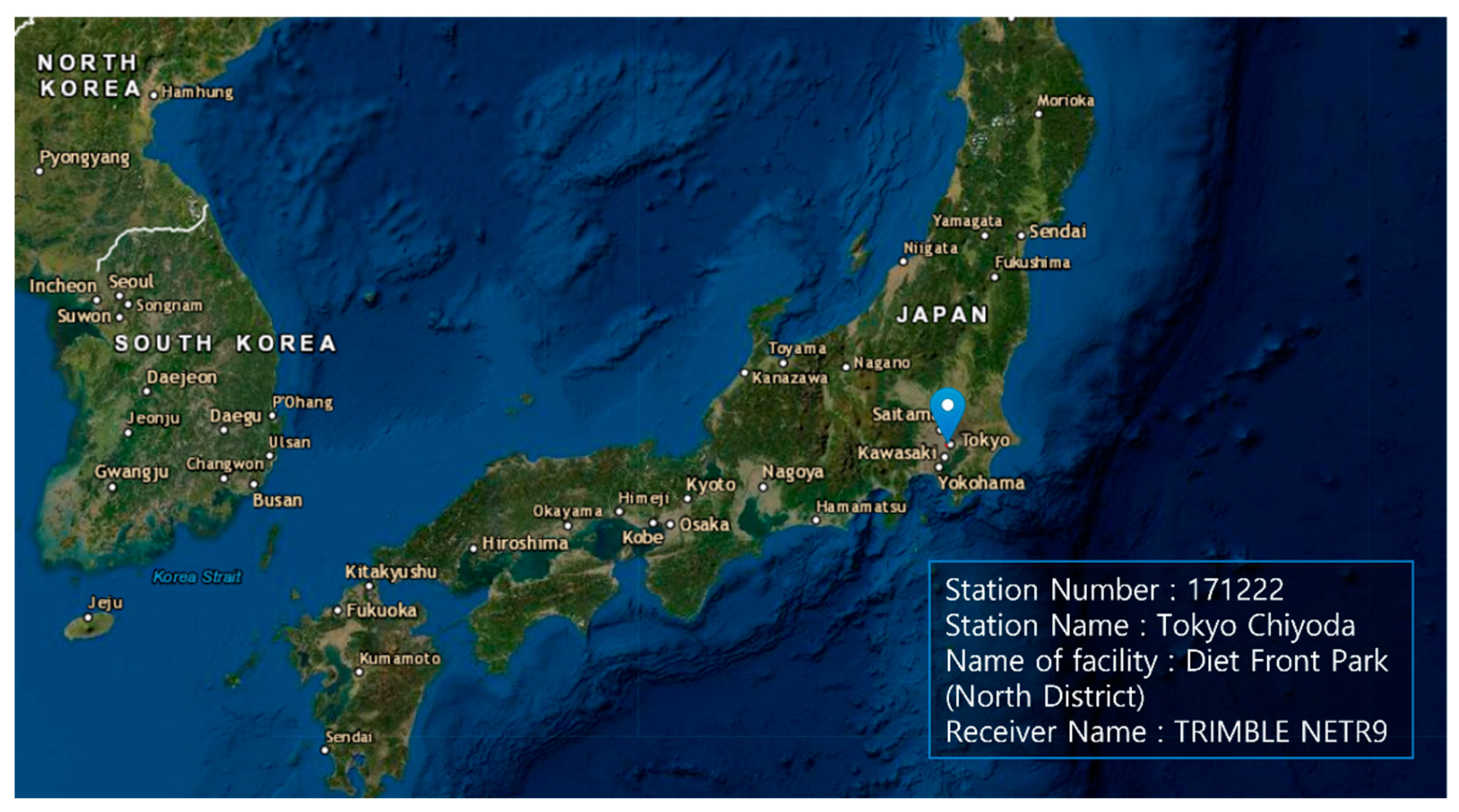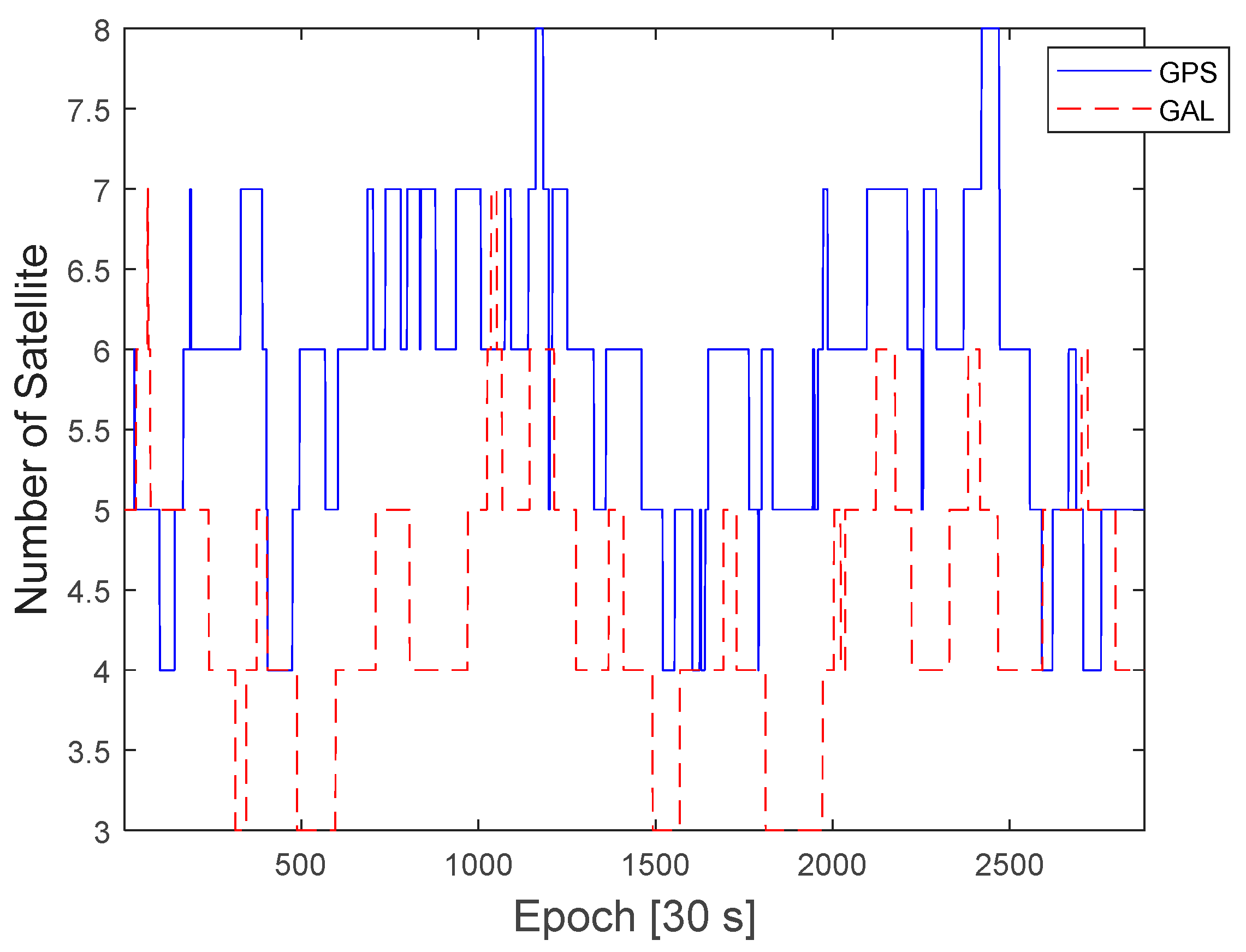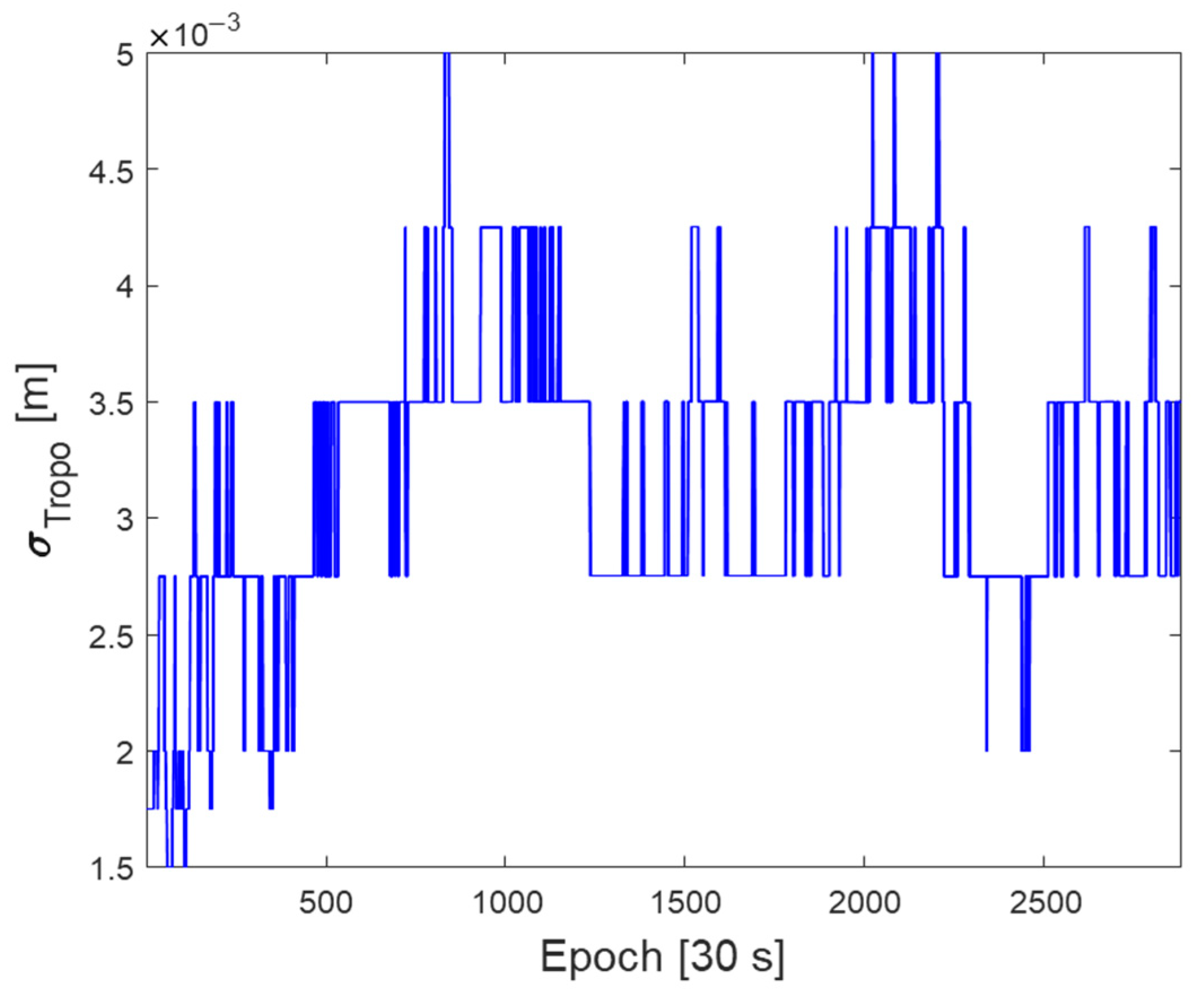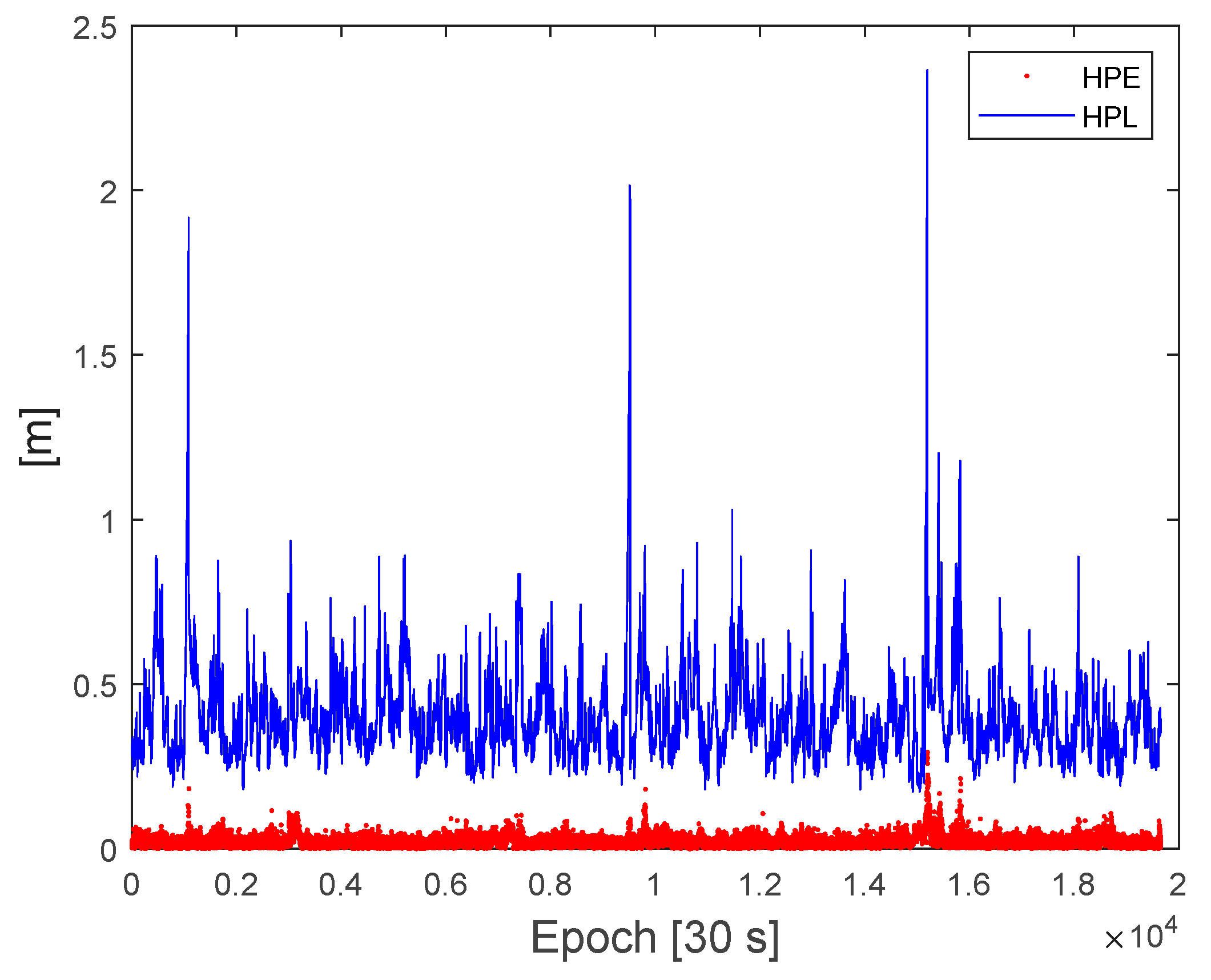Fault-Free Protection Level Equation for CLAS PPP-RTK and Experimental Evaluations
Abstract
1. Introduction
2. Overview of the CLAS Broadcast Messages
3. Proposed Fault-Free Protection Level Equations for CLAS PPP-RTK Service
3.1. Fault-Free Protection Level Equations of SBAS
3.2. Overview of Least-Squares Ambiguity Decorrelation Adjustment (LAMBDA)
3.3. Proposed Fault-Free PPP-RTK Protection Level Equation
4. Evaluation of the Proposed Protection Levels for PPP-RTK
4.1. Experimental Data Processing
4.2. Comparison of the VRS-RTK Position Errors and Computed Protection Levels
5. Discussion
6. Conclusions
Author Contributions
Funding
Acknowledgments
Conflicts of Interest
References
- Pervan, B. Ground-Based Augmentation System. In Position, Navigation, and Timing Technologies in the 21st Century: Integrated Satellite Navigation, Sensor Systems, and Civil Applications, Volume 1; Wiley: Hoboken, NJ, USA, 2020; pp. 259–276. [Google Scholar]
- Walter, T. Satellite Based Augmentation Systems. In Springer Handbook of Global Navigation Satellite Systems; Springer: Cham, Switzerland, 2017; pp. 339–361. [Google Scholar]
- Pullen, S.; Walter, T.; Enge, P. SBAS and GBAS Integrity for Non-Aviation Users: Moving Away from “Specific Risk”. In Proceedings of the 2011 International Technical Meeting of The Institute of Navigation, San Diego, CA, USA, 24–26 January 2011; pp. 533–545. [Google Scholar]
- Pullen, S. Augmented GNSS: Fundamentals and Keys to Integrity and Continuity. Available online: http://www-leland.stanford.edu/~spullen/ION12_tutorial.pdf (accessed on 25 March 2022).
- DeCleene, B. Defining Pseudorange Integrity-Overbounding. In Proceedings of the 13th International Technical Meeting of the Satellite Division of The Institute of Navigation (ION GPS 2000), Salt Lake City, UT, USA, 19–22 September 2000; pp. 1916–1924. [Google Scholar]
- Rife, J.; Pullen, S.; Pervan, B.; Enge, P. Paired Overbounding and Application to GPS Augmentation. In Proceedings of the PLANS 2004. Position Location and Navigation Symposium (IEEE Cat. No.04CH37556), Monterey, CA, USA, 26–29 April 2004; pp. 439–446. [Google Scholar]
- Rife, J.; Pullen, S.; Pervan, B. Core Overbounding and Its Implications for LAAS Integrity. In Proceedings of the 17th International Technical Meeting of the Satellite Division of The Institute of Navigation (ION GNSS 2004), Long Beach, CA, USA, 21–24 September 2004; pp. 2810–2821. [Google Scholar]
- Walter, T.; Blanch, J.; Rife, J. Treatment of Biased Error Distributions in SBAS. J. Glob. Position. Syst. 2004, 3, 265–272. [Google Scholar] [CrossRef][Green Version]
- Miya, M.; Fujita, S.; Sato, Y.; Ota, K.; Hirokawa, R.; Takiguchi, J. Centimeter Level Augmentation Service (CLAS) in Japanese Quasi-Zenith Satellite System, Its User Interface, Detailed Design, and Plan. In Proceedings of the 29th International Technical Meeting of the Satellite Division of The Institute of Navigation (ION GNSS+ 2016), Portland, OR, USA, 12–16 September 2016; pp. 2864–2869. [Google Scholar]
- Miya, M.; Fujita, S.; Sato, Y.; Kaneko, K.; Shima, Y.; Hirokawa, R.; Sone, H.; Takiguchi, J. Centimeter Level Augmentation Service (CLAS) in Japanese Quasi-Zenith Satellite System, Design for Satellite Based RTK-PPP Services. In Proceedings of the 28th International Technical Meeting of the Satellite Division of The Institute of Navigation (ION GNSS+ 2015), Tampa, FL, USA, 14–18 September 2015; pp. 1958–1962. [Google Scholar]
- Miya, M.; Sato, Y.; Fujita, S.; Motooka, N.; Saito, M.; Takiguchi, J. Centimeter Level Augmentation Service (CLAS) in Japaneses Quasi-Zenith Satellite System, Its Preliminary Design and Plan. In Proceedings of the 27th International Technical Meeting of the Satellite Division of The Institute of Navigation (ION GNSS+ 2014), Tampa, FL, USA, 8–12 September 2014; pp. 645–652. [Google Scholar]
- Fujita, S.; Sato, Y.; Miya, M.; Ota, K.; Hirokawa, R.; Takiguchi, J. Design of Integrity Function on Centimeter Level Augmentation Service (CLAS) in Japanese Quasi-Zenith Satellite System. In Proceedings of the 29th International Technical Meeting of the Satellite Division of The Institute of Navigation (ION GNSS+ 2016), Portland, OR, USA, 12–16 September 2016; pp. 3258–3263. [Google Scholar]
- Hirokawa, R.; Sato, Y.; Fujita, S.; Miya, M. Compact SSR Messages with Integrity Information for Satellite Based PPP-RTK Service. In Proceedings of the 29th International Technical Meeting of the Satellite Division of The Institute of Navigation (ION GNSS+ 2016), Portland, OR, USA, 12–16 September 2016; pp. 3372–3376. [Google Scholar]
- Feng, S.; Ochieng, W.; Moore, T.; Hill, C.; Hide, C. Carrier Phase-Based Integrity Monitoring for High-Accuracy Positioning. GPS Solut. 2009, 13, 13–22. [Google Scholar] [CrossRef]
- Madrid, P.; Saenz, M.; Varo, C.; Schortmann, J. Computing Meaningful Integrity Bounds of a Low-Cost Kalman-Filtered Navigation Solution in Urban Environments. In Proceedings of the 28th International Technical Meeting of the Satellite Division of The Institute of Navigation (ION GNSS+ 2015), Tampa, FL, USA, 14–18 September 2015; pp. 2914–2925. [Google Scholar]
- Azaola, M.; Calle, D.; Mozo, A.; Piriz, R. Autonomous Isotropy-Based Integrity Using GPS and GLONASS. In Proceedings of the 23rd International Technical Meeting of the Satellite Division of The Institute of Navigation (ION GNSS 2010), Portland, OR, USA, 21–24 September 2010; pp. 2135–2147. [Google Scholar]
- El-Mowafy, A.; Kubo, N. Integrity Monitoring of Vehicle Positioning in Urban Environment Using RTK-GNSS, IMU and Speedometer. Meas. Sci. Technol. 2017, 28, 055102. [Google Scholar] [CrossRef]
- Blanch, J.; Walter, T.; Enge, P.; Wallner, S.; Fernandez, F.; Dellago, R.; Ioannides, R.; Hernandez, I.; Belabbas, B.; Spletter, A.; et al. Critical Elements for a Multi-Constellation Advanced RAIM. Navig. J. Inst. Navig. 2013, 60, 53–69. [Google Scholar] [CrossRef]
- Khanafseh, S.; Pervan, B. New Approach for Calculating Position Domain Integrity Risk for Cycle Resolution in Carrier Phase Navigation Systems. IEEE Trans. Aerosp. Electron. Syst. 2010, 46, 296–307. [Google Scholar] [CrossRef]
- Zabalegui, P.; De Miguel, G.; Perez, A.; Mendizabal, J.; Goya, J.; Adin, I. A Review of the Evolution of the Integrity Methods Applied in GNSS. IEEE Access 2020, 8, 45813–45824. [Google Scholar] [CrossRef]
- Japan Cabinet Office. Quasi-Zenith Satellite System Interface Specification: Centimeter Level Augmentation Service (IS-QZSS-L6-004), July 2021. Available online: https://qzss.go.jp/en/technical/download/pdf/ps-is-qzss/is-qzss-l6-004.pdf (accessed on 25 March 2022).
- de Jonge, P.; Tiberius, C. Integer Ambiguity Estimation with the Lambda Method. In GPS Trends in Precise Terrestrial, Airborne, and Spaceborne Applications; Springer: Berlin/Heidelberg, Germany, 1996; pp. 280–284. [Google Scholar]
- Teunissen, P.J.G. Least-Squares Estimation of the Integer GPS Ambiguities. Available online: https://gnss.curtin.edu.au/wp-content/uploads/sites/21/2016/04/Teunissen1993Least.pdf (accessed on 25 March 2022).
- Teunissen, P.J.G. Success Probability of Integer GPS Ambiguity Rounding and Bootstrapping. J. Geod. 1998, 72, 606–612. [Google Scholar] [CrossRef]
- Welcome to GSI|GSI HOME PAGE. Available online: https://www.gsi.go.jp/ENGLISH/ (accessed on 21 March 2022).
- Centimeter Level Augmentation Service (CLAS)|Service Overview|QZSS (Quasi-Zenith Satellite System)—Cabinet Office (Japan). Available online: https://qzss.go.jp/en/overview/services/sv06_clas.html (accessed on 21 March 2022).
- EarthExplorer. Available online: https://earthexplorer.usgs.gov/ (accessed on 6 May 2022).
- Takasu, T.; Yasuda, A. Development of the Low-Cost RTK-GPS Receiver with an Open Source Program Package RTKLIB. In Proceedings of the International symposium on GPS/GNSS, Seogwipo, Korea, 4–6 November 2009. [Google Scholar]
- Rispoli, F.; Enge, P.; Neri, A.; Senesi, F.; Ciaffi, M.; Razzano, E. GNSS for Rail Automation & Driverless Cars: A Give and Take Paradigm. In Proceedings of the 31st International Technical Meeting of the Satellite Division of The Institute of Navigation (ION GNSS+ 2018), Miami, FL, USA, 24–28 September 2018; pp. 1468–1482. [Google Scholar] [CrossRef]









| Message Name | Message Type ID Subtype ID | Nominal Validity Period [s] | Nominal Update Interval [s] |
|---|---|---|---|
| Compact SSR Mask | MT4073,1 | 1 | 30 |
| Compact SSR GNSS Orbit Correction | MT4073,2 | 60 | 30 |
| Compact SSR GNSS Clock Correction | MT4073,3 | 10 | 5 |
| Compact SSR GNSS Satellite Code Bias | MT4073,4 | 60 | 30 |
| Compact SSR GNSS Satellite Phase Bias | MT4073,5 | 60 | 30 |
| Compact SSR GNSS Satellite Code and Phase Bias | MT4073,6 | 60 | 30 |
| Compact SSR GNSS URA | MT4073,7 | 60 | 30 |
| Compact SSR STEC Correction | MT4073,8 | 60 | 30 |
| Compact SSR Gridded Correction | MT4073,9 | 60 | 30 |
| Compact SSR Service Information | MT4073,10 | (N/A) | (N/A) |
| Compact SSR GNSS Combined Correction | MT4073,11 | 10 or 60 | 5 or 30 |
| Compact SSR Atmospheric Correction | MT4073,12 | 60 | 30 |
Publisher’s Note: MDPI stays neutral with regard to jurisdictional claims in published maps and institutional affiliations. |
© 2022 by the authors. Licensee MDPI, Basel, Switzerland. This article is an open access article distributed under the terms and conditions of the Creative Commons Attribution (CC BY) license (https://creativecommons.org/licenses/by/4.0/).
Share and Cite
Kim, E.; Song, J.; Shin, Y.; Kim, S.; Son, P.-W.; Park, S.; Park, S. Fault-Free Protection Level Equation for CLAS PPP-RTK and Experimental Evaluations. Sensors 2022, 22, 3570. https://doi.org/10.3390/s22093570
Kim E, Song J, Shin Y, Kim S, Son P-W, Park S, Park S. Fault-Free Protection Level Equation for CLAS PPP-RTK and Experimental Evaluations. Sensors. 2022; 22(9):3570. https://doi.org/10.3390/s22093570
Chicago/Turabian StyleKim, Euiho, Jaeyoung Song, Yujin Shin, Saekyul Kim, Pyo-Woong Son, Sulgee Park, and Sanghyun Park. 2022. "Fault-Free Protection Level Equation for CLAS PPP-RTK and Experimental Evaluations" Sensors 22, no. 9: 3570. https://doi.org/10.3390/s22093570
APA StyleKim, E., Song, J., Shin, Y., Kim, S., Son, P.-W., Park, S., & Park, S. (2022). Fault-Free Protection Level Equation for CLAS PPP-RTK and Experimental Evaluations. Sensors, 22(9), 3570. https://doi.org/10.3390/s22093570







